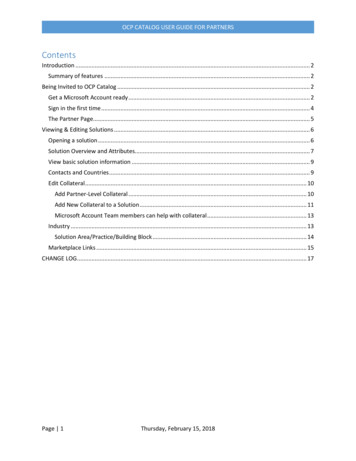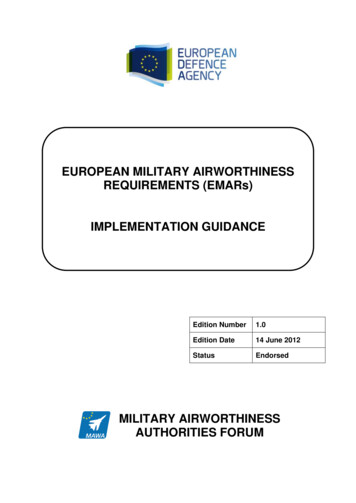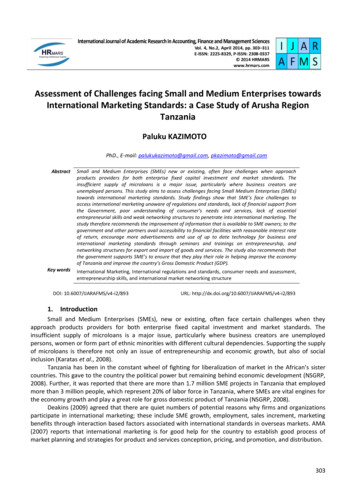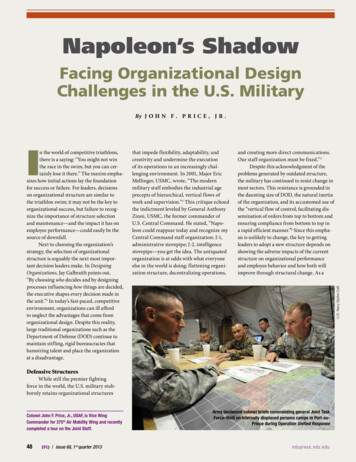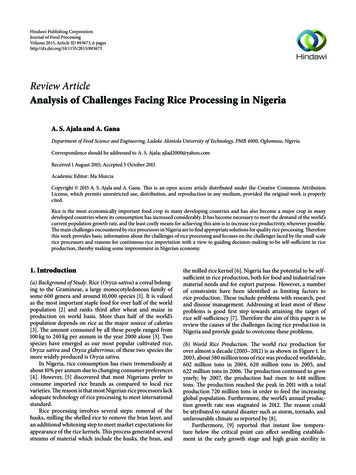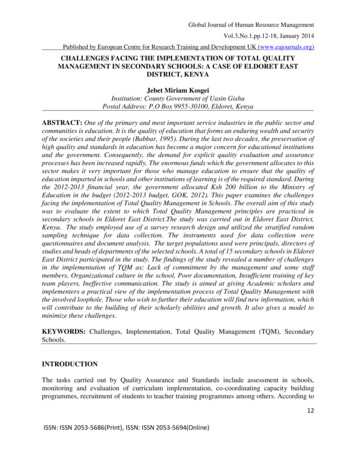
Transcription
Global Journal of Human Resource ManagementVol.3,No.1,pp.12-18, January 2014Published by European Centre for Research Training and Development UK (www.eajournals.org)CHALLENGES FACING THE IMPLEMENTATION OF TOTAL QUALITYMANAGEMENT IN SECONDARY SCHOOLS: A CASE OF ELDORET EASTDISTRICT, KENYAJebet Miriam KosgeiInstitution: County Government of Uasin GishuPostal Address: P.O Box 9955-30100, Eldoret, KenyaABSTRACT: One of the primary and most important service industries in the public sector andcommunities is education. It is the quality of education that forms an enduring wealth and securityof the societies and their people (Babbar, 1995). During the last two decades, the preservation ofhigh quality and standards in education has become a major concern for educational institutionsand the government. Consequently, the demand for explicit quality evaluation and assuranceprocesses has been increased rapidly. The enormous funds which the government allocates to thissector makes it very important for those who manage education to ensure that the quality ofeducation imparted in schools and other institutions of learning is of the required standard. Duringthe 2012-2013 financial year, the government allocated Ksh 200 billion to the Ministry ofEducation in the budget (2012-2013 budget, GOK, 2012). This paper examines the challengesfacing the implementation of Total Quality Management in Schools. The overall aim of this studywas to evaluate the extent to which Total Quality Management principles are practiced insecondary schools in Eldoret East District.The study was carried out in Eldoret East District,Kenya. The study employed use of a survey research design and utilized the stratified randomsampling technique for data collection. The instruments used for data collection werequestionnaires and document analysis. The target populations used were principals, directors ofstudies and heads of departments of the selected schools. A total of 15 secondary schools in EldoretEast District participated in the study. The findings of the study revealed a number of challengesin the implementation of TQM as; Lack of commitment by the management and some staffmembers, Organizational culture in the school, Poor documentation, Insufficient training of keyteam players, Ineffective communication. The study is aimed at giving Academic scholars andimplementers a practical view of the implementation process of Total Quality Management withthe involved loophole. Those who wish to further their education will find new information, whichwill contribute to the building of their scholarly abilities and growth. It also gives a model tominimize these challenges.KEYWORDS: Challenges, Implementation, Total Quality Management (TQM), SecondarySchools.INTRODUCTIONThe tasks carried out by Quality Assurance and Standards include assessment in schools,monitoring and evaluation of curriculum implementation, co-coordinating capacity buildingprogrammes, recruitment of students to teacher training programmes among others. According to12ISSN: ISSN 2053-5686(Print), ISSN: ISSN 2053-5694(Online)
Global Journal of Human Resource ManagementVol.3,No.1,pp.12-18, January 2014Published by European Centre for Research Training and Development UK (www.eajournals.org)a Quality Assurance and Standards report by the DQASO, Eldoret East District, Quality Assuranceand Standards is faced with challenges which include the following:Inadequate budgetary allocation: Adequate financing is required to enable Quality Assuranceactivities to run smoothly. There is inadequate budgetary allocation to the directorate of qualityassurance and standards.Lack of transport: This is because there are few vehicles and the few available are not wellmaintained. This makes mobility of the officers to the fields difficult.Poor motivation and job dissatisfaction: The frustrations experienced by quality assurance andstandards officers make them to lose morale thus job dissatisfaction. Poor terms and conditions ofwork also contribute to job dissatisfaction. The officers are not given good remuneration packages.Sometimes their salaries are lower than those of the officers they inspect in the field.Lack of pre-service and in-service training: There are no regular in-service courses for updatingskills of the quality assurance and standards officers. Coupled with the lack of a definite staffdevelopment policy, the problem of inadequacies in skills has arisen.There is understaffing of schools: This is occasioned by the freezing of employment of teachers.Quality and staffing go hand- in- hand. Metobo (2011) in his letter to the editor on the teacher’sstrike argued that many schools were disadvantaged as far as staffing is concerned. He stated thatthe strike was about bridging the gap to ensure quality teaching. Mbindyo (2011) on the same issueargued that the strike was not just about pay but rather it was about employing more teachers toimprove the quality of Education in KenyaBarriers in the Implementation of TQMSallis (2002) identifies various barriers to the successful implementation of TQM as discussed inthis section. The author acknowledges that TQM is hard work. It takes time to develop a qualityculture. By themselves hard work and time are two of the most formidable blocking mechanismsto quality improvement. TQM needs a champion in the face of the myriad of new challenges andchanges facing education. Quality improvement is a fragile process. Cultures are essentiallyconservative and homeostasis is the norm. The members of staff in any organization are mostcomfortable with what they know and understand. However, to stand still while competitors areimproving is a recipe for failure.Sallis (2002) further argues that if TQM is to work it must have the long-term devotion of thesenior staff of the institution. They must back it and drive it. Senior management may themselvesbe the problem. They may want the results that TQM can bring, but be unwilling to give it theirwholehearted support. Many quality initiatives falter because senior managers quickly return totraditional ways of managing. Fear by senior managers of adopting new methods is a major barrier.If senior management do not give TQM their backing there is little that anyone else in theorganization can do.The sheer volume of external pressures also stands in the way of many organizations attemptingTQM. Although quality programmes are introduced with considerable publicity, too often theycan be overtaken and submerged by other initiatives. There is a need to ensure that quality always13ISSN: ISSN 2053-5686(Print), ISSN: ISSN 2053-5694(Online)
Global Journal of Human Resource ManagementVol.3,No.1,pp.12-18, January 2014Published by European Centre for Research Training and Development UK (www.eajournals.org)has an important place on the agenda of an organization. This is where strategic planning playssuch an important role. If TQM is firmly a part of the strategic role of the institution, and if thereare good monitoring mechanisms in place, then there is a good chance that quality will keep a highprofile. This makes it harder to ignore, and increases the chances of it being taken seriously(Deming, 1986).The strategic plan can help staff understand the institution’s mission. It helps to bridge gaps incommunication. There is a need for staff to know where their institution is going and how it willbe different in the future. Senior managers must trust their staff sufficiently to share their visionfor the institution’s future. Visions are often not shared because of a fear of a loss of status anddisempowerment by managers. When coupled with a fear of delegation by managers, this canmake quality development nearly impossible. Managers have to be able to let their staff takedecisions and be willing to see them make honest mistakes (McCulloch, 1993).The strategic planis therefore an avenue to the realization of total quality management practices through planning,implementation of the plans, monitoring and evaluation of programmes which will lead tocontinuous improvement in an organization. With such programmes in place there is bound to bean improvement in the quality of service delivery.A potential problem area in many institutions is the role played by middle management. They havea pivotal role because they both maintain the day-to-day operation of the institution and act as oneof its most important communications channels. They can often block change if they have a mindto or they can act as the leaders of teams spearheading the impetus for quality improvement.Middle managers may not define their role as one of innovation unless senior managementcommunicates to them their vision of a new future. Senior managers must be consistent in theirbehaviour when advocating and communicating the message of quality improvement. They cannotsay one thing and do another and then expect to engender enthusiasm among their staff or loyaltyand commitment in their middle managers. They have to persuade others that new workingmethods will pay dividends.Barriers to quality are not the sole prerogative of managers (Deming, 1986). Many staff fear theconsequences of empowerment, especially if things go wrong. They are often comfortable withsameness. They need to have the benefits demonstrated to them. For this reason TQM must avoidbeing about nothing but jargon and hype. This can easily lead to a loss of interest and to skepticismand cynicism, and to the belief that nothing makes any difference. Many of the barriers to TQMinvolve an element of fear and uncertainty. Fear of the unknown, of doing things differently, oftrusting others, and of making mistakes, are powerful defense and resistance mechanisms. Staffcannot give of their best unless they feel that they are trusted and their views listened to. Deming(1986) argues that it is essential when undertaking the quality revolution to ‘drive out fear’, and itis imperative to take this message seriously when building a quality institution. This is becausehuman beings resist change due to fear of the unknown.14ISSN: ISSN 2053-5686(Print), ISSN: ISSN 2053-5694(Online)
Global Journal of Human Resource ManagementVol.3,No.1,pp.12-18, January 2014Published by European Centre for Research Training and Development UK (www.eajournals.org)METHODOLOGYThe study was an examination of the challenges the hinder implementation of Quality andStandards in Schools with a focus on Eldoret East District, Kenya. Schools that were involved inthe study included; Day mixed schools, Boarding mixed schools, Day/ boarding schools, Boysboarding and Girls boarding. The study employed use of a survey research design and utilized thestratified random sampling technique for data collection. The instruments used for data collectionwere questionnaires and document analysis. The target populations used were principals, directorsof studies and heads of departments of the selected schools. A total of 15 secondary schools inEldoret East District participated in the study. Descriptive statistics were used to analyze the data.RESULTS AND DISCUSSIONChallenges Facing Implementation of Total Quality Management (TQM)One item in the Principals’ questionnaire sought to find out the challenges facing implementationof TQM in schools. A total of fifteen (100%) responses were received. Analysis and interpretationof data revealed that twelve (80%) indicated lack of funds, eleven (73.3%) indicated poormotivation and job satisfaction among team players, fourteen (93.3%) indicated lack of pre-serviceand in-service training, two (13.3%) indicated understaffing, seven (46.7%) indicated resistanceto change by major stakeholders and ten (66.7%) indicated role ambiguity. This is shown in Table1 below.Table 1: Challenges facing implementation of TQM PracticesNO CRITERIALack of funds1Poor motivation and job satisfaction among team players2Lack of pre-service and in-service training3Understaffing4Resistance to change by major stakeholders5Role ambiguity6Source: Survey Data, 2014FREQUENCY1211142710%8073.393.313.346.766.7On the HODs questionnaire, the author sought to find out the challenges in implementation ofquality management practice. A total of one hundred and thirty five (100%) responses werereceived. Analysis and interpretation of data revealed that on the scale of strongly agree, onehundred and thirty five (100%) indicated lack of commitment by the management and some staffmembers, one hundred and thirty (96.3%) indicated organizational culture in the school, five(3.7%) indicated poor documentation, five (3.7%) indicated insufficient training of key teamplayers and eighty (59.3%) indicated ineffective communication. This is shown in Table 2.15ISSN: ISSN 2053-5686(Print), ISSN: ISSN 2053-5694(Online)
Global Journal of Human Resource ManagementVol.3,No.1,pp.12-18, January 2014Published by European Centre for Research Training and Development UK (www.eajournals.org)Table 2: Challenges Facing Implementation of Quality Management PracticesNO CRITERIAFREQUENCYLack of commitment by the management and some staff 1351membersOrganizational culture in the school1302Poor documentation53Insufficient training of key team players54Ineffective communication805Source: Survey Data, 2014%10096.33.73.759.3DISCUSSIONThe study found out that the implementation of TQM faced many challenges. As much as theteachers were professionally trained and experienced, the responses indicated that lack ofcommitment by management and some staff members (100%), Organizational culture in the school(96.3%), lack of pre-service and in-service training (93.3%), lack of funds (80%), poor motivationand job satisfaction among team players (73.3%), role ambiguity and ineffective communication(59.3%) were the major challenges in the implementation of TQM practices in secondary schoolsin Eldoret East District. This study has further established that secondary schools in Eldoret Eastface a number of challenges that include; lack of commitment by staff, poor organization cultures,lack of training, and lack of team work, poor documentation and records keeping among othersthat had a significant negative bearing on TQM. These challenges need to be addressed for TQMto be attained in secondary schools. The study noted that team work, timely planning and adequatesupervision were necessary to ensure the actualization of TQM. Provision of adequate resourcesand relevant training would provide a favorable environment for the attainment of TQM atsecondary schools at Eldoret East.Although the Ministry of Education embraced TQM after its ISO certification in 2007 the disparityin performance of various schools calls for the need to ascertain the extent to which TQMprinciples are practiced and the challenges facing its implementation. The author recommends amodel that if implemented will create a conducive environment for implementation of TQM.RECOMMENDATIONThe study proposes a model that could be used to ensure the proper implementation of TQM insecondary schools in Eldoret East. The suggested model presents six stages that secondary schoolsin Eldoret East would have to go through to ensure there is conducive environment for theactualization of TQM. These stages and requirements are shown in Figure 1.16ISSN: ISSN 2053-5686(Print), ISSN: ISSN 2053-5694(Online)
Global Journal of Human Resource ManagementVol.3,No.1,pp.12-18, January 2014Published by European Centre for Research Training and Development UK (www.eajournals.org)The model has five phases namely: Needs analysis, training, role of HODS, continuous monitoringand evaluation as shown in figure 1 below:STEP 2TRAININGSTEP 1NEEDSANALYSISSTEP 6STEP 5CHALLENGESACTUALIZATIONOF TQMSTEP 3ROLES OFHODsSTEP 4MONITORING& EVALUATION(insert a minus sign below the arrow on challenges coz challenges have to be minimized)Figure 1: Proposed TQM Implementation Framework for Secondary SchoolsSource: Survey Data, 2014i.ii.iii.iv.v.Step 1- Needs analysisThe starting point in implementation of TQM is to carry out a needs analysis of the organization.The needs analysis should also be carried out among the staff, students and other stakeholders ofsecondary schools so as to establish the following:Staff capacity building levels within secondary schools, It will further examine the knowledgeand skills gaps of these staff in TQM.The needs of the users, staff and stakeholders, of the secondary schools.The required resources, Financial and human capital among others, that are necessary for theimplementation of TQM secondary schools.The policies and procedures put in place in secondary schools, to provide guidelines onimplementation of TQM.Needs analysis should be carried out continuously in view of the dynamic environment.Step 2 –TrainingThere should be continuous training on staff as regard to TQM developments. New staff shouldadequately be inducted on TQM implementation and the management should make known theirexpectation from the staff. Responsibilities should be clearly spelled out.17ISSN: ISSN 2053-5686(Print), ISSN: ISSN 2053-5694(Online)
Global Journal of Human Resource ManagementVol.3,No.1,pp.12-18, January 2014Published by European Centre for Research Training and Development UK (www.eajournals.org)Step 3- Roles of Heads of DepartmentsThe HODs have the invaluable role of championing for TQM in their schools.HODs have a major role to play in spearheading the walk towards successful implementation ofTQM in secondary schools.The HODs also play a paramount role of supervising staff under them to ensure they perform asper required standards.Step 4 -Monitoring and EvaluationContinuous monitoring and evaluation is vital for the implementation and the sustainability ofTQM in secondary schools in Eldoret east. This therefore requires that record keeping and properdocumentation is done in schools. This is vital as it provides the necessary evidence to analyzetrends that are crucial for the monitoring and evaluation process.Step 5- Minimization of ChallengesChallenges are a great impediment towards the implementation and sustainability of TQMpractices in secondary schools at Eldoret east. It’s for this reason that schools should strive toeliminate if not minimize factors that slows down the pace of implementation of TQM in schoolssuch as: lack of commitment, lack of team work, poor documentation and record-keeping amongothers.Step 6 -Actualization of TQMWhen the above six factors are well factored in as shown in the model, then the actualization ofTQM can be achieved in secondary schools. However other external factors may help improve theintake of TQM in secondary schools such as having in place policies and procedures onimplementation of TQM to provide guidance and spell out responsibilities of parties concernedfurthermore the adoption of information communication technology (ICT) can help improve andsustain the implementation of TQM in Secondary Schools.REFERENCESBabbar, (1995). Applying total quality management to educational instruction: A case study froma US Public University. International Journal of Public Sector Management. 8 (7) pp. 3555.Deming, W. E. (1986). Out of Crisis. Cambridge: Cambridge University Press.Government of Kenya (2012). Ministry of Finance: 2012-2013 Budget. Nairobi: GovernmentPrinters.McCulloch, M. (1993). Total quality management: its relevance for higher education:QualityAssurance in Education,1(2).Metobo J. (2011, Sept, 13th). The Daily Nation, p. 8.Sallis, E. (2002). Total Quality Management in Education, 3rd ed. London: Kogan Page.18ISSN: ISSN 2053-5686(Print), ISSN: ISSN 2053-5694(Online)
Global Journal of Human Resource Management Vol.3,No.1,pp.12-18, January 2014 Published by European Centre for Research Training and Development UK (www.eajournals.org) 12 ISSN: ISSN 2053-5686(Print), ISSN: ISSN 2053-5694(Online) CHALLENGES FACING THE IMPLEMENTATION OF TOTAL QUALITY MANAGEMENT IN SECONDARY SCHOOLS: A CASE OF ELDORET EAST



